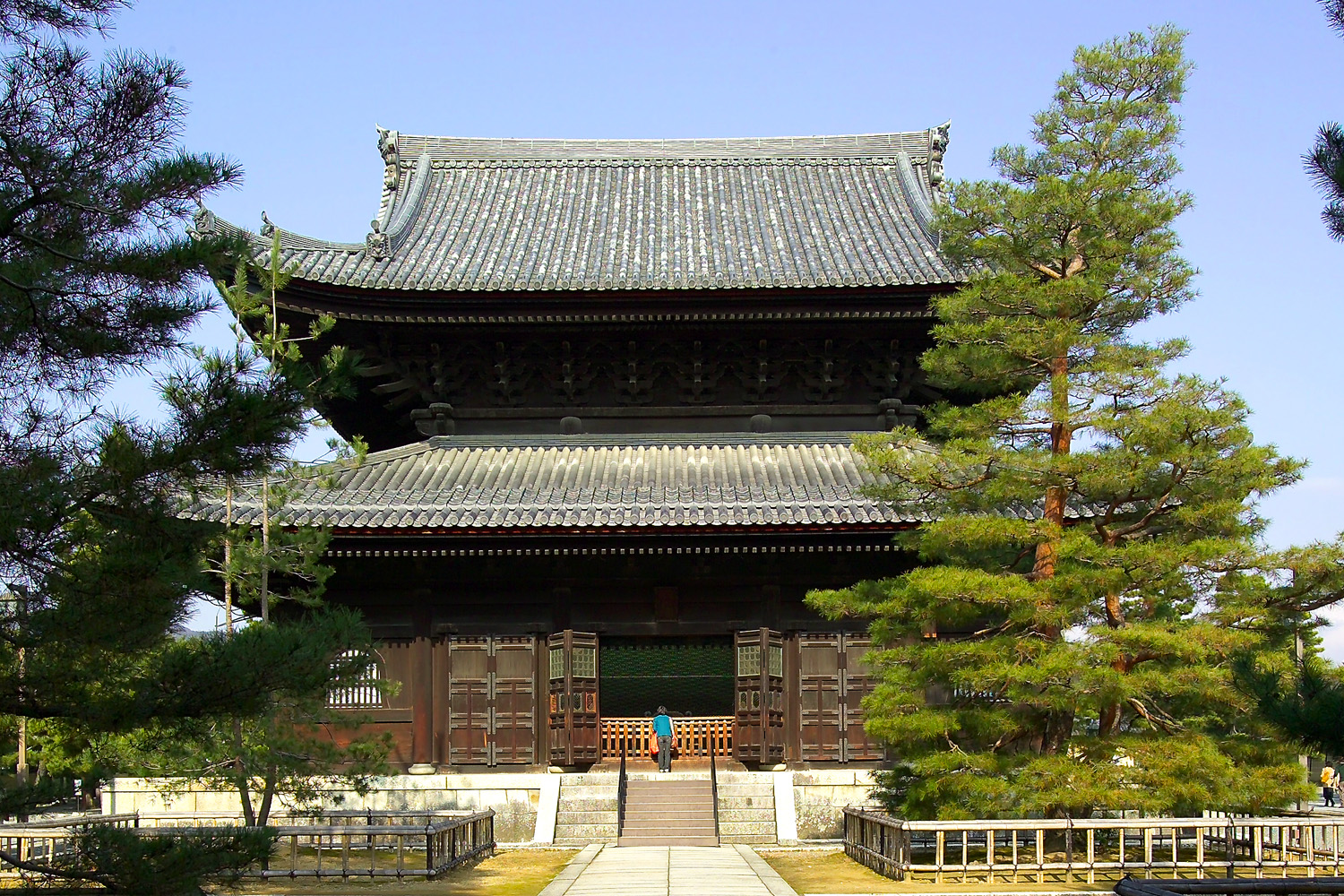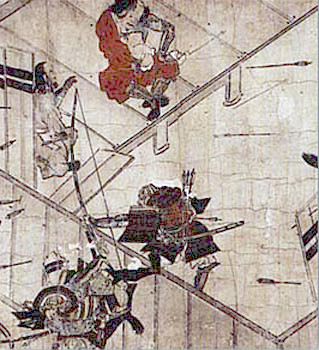|
Ashikaga Yoshinori
was the sixth ''shōgun'' of the Ashikaga shogunate who reigned from 1429 to 1441 during the Muromachi period of medieval Japan. Yoshinori was the son of the third ''shōgun'' Ashikaga Yoshimitsu. Titsingh, Isaac. (1834). His childhood name was Harutora (). In 1433, he initiated the compilation of the last imperial ''waka'' anthology, '' Shinshoku Kokinwakashū'', but was not satisfied with its compilation agenda which undermined his authority. Shogunal succession and reign After the death of the fifth ''shōgun'' Ashikaga Yoshikazu in 1425, the fourth ''Shōgun'' Ashikaga Yoshimochi resumed his role as head of the shogunate. Yoshimochi had no other sons, nor did he name a successor before he himself died in 1428. Yoshinori, who had been a Buddhist monk since the age of ten, became '' Sei-i Taishōgun'' on the day of Yoshimochi's death. From amongst the handful of possible Ashikaga candidates, his name was selected by the shogunal deputy ('' Kanrei''), Hatakeyama Mits ... [...More Info...] [...Related Items...] OR: [Wikipedia] [Google] [Baidu] [Amazon] |
Shōgun
, officially , was the title of the military rulers of Japan during most of the period spanning from 1185 to 1868. Nominally appointed by the Emperor, shoguns were usually the de facto rulers of the country, except during parts of the Kamakura period and Sengoku period when the shoguns themselves were figureheads, with real power in the hands of the of the Hōjō clan and of the Hosokawa clan. In addition, Taira no Kiyomori and Toyotomi Hideyoshi were leaders of the warrior class who did not hold the position of shogun, the highest office of the warrior class, yet gained the positions of and , the highest offices of the aristocratic class. As such, they ran their governments as its de facto rulers. The office of shogun was in practice hereditary, although over the course of the history of Japan several different clans held the position. The title was originally held by military commanders during the Heian period in the eighth and ninth centuries. When Minamoto no Y ... [...More Info...] [...Related Items...] OR: [Wikipedia] [Google] [Baidu] [Amazon] |
Akamatsu Mitsusuke
was a Japanese samurai of the Akamatsu clan during the Muromachi Period. Nussbaum, Louis-Frédéric. (2005) "''Kaikitsu-no-hen,''"''Japan encyclopedia,'' p. 456. Other sources say he was born in 1373. Family Mitsusuke was the son of Akamatusu Yoshinori and father of Akamatsu Noriyasu. Assassination of the Shogun and death In 1441, Mitsusuke killed the reigning Ashikaga shogunate, Ashikaga Yoshinori, in response to the Shogun's choice of one of his rivals, Akamatsu Sadaura, as head of the clan. In response, he was attacked by forces of the Yamana clan and the Hosokawa clan The is a Japanese samurai kin group or Japanese clan, clan. The clan descends from the Seiwa Genji, a branch of the Minamoto clan, and ultimately from Emperor Seiwa, through the Ashikaga clan. It produced many prominent officials in the Ashikaga .... In defeat, he was forced to commit suicide. References Daimyo Suicides by seppuku 1381 births 1441 deaths Forced suicides {{Samurai-st ... [...More Info...] [...Related Items...] OR: [Wikipedia] [Google] [Baidu] [Amazon] |
Tang Dynasty
The Tang dynasty (, ; zh, c=唐朝), or the Tang Empire, was an Dynasties of China, imperial dynasty of China that ruled from 618 to 907, with an Wu Zhou, interregnum between 690 and 705. It was preceded by the Sui dynasty and followed by the Five Dynasties and Ten Kingdoms period. Historians generally regard the Tang as a high point in Chinese civilisation, and a Golden age (metaphor), golden age of cosmopolitan culture. Tang territory, acquired through the military campaigns of its early rulers, rivalled that of the Han dynasty. The House of Li, Li family founded the dynasty after taking advantage of a period of Sui decline and precipitating their final collapse, in turn inaugurating a period of progress and stability in the first half of the dynasty's rule. The dynasty was formally interrupted during 690–705 when Empress Wu Zetian seized the throne, proclaiming the Wu Zhou dynasty and becoming the only legitimate Chinese empress regnant. The An Lushan rebellion (755 ... [...More Info...] [...Related Items...] OR: [Wikipedia] [Google] [Baidu] [Amazon] |
Main Hall (Japanese Buddhism)
Main hall or Main Temple is the building within a Japanese Buddhist monastery compound ('' garan'') which enshrines the main object of veneration.Kōjien Japanese dictionary Because the various denominations deliberately use different terms, this single English term translates several Japanese words, among them ''butsuden'', ''butsu-dō'', ''kondō'', ''konpon-chūdō'', and ''hondō''. ''Hondō'' is its exact Japanese equivalent, while the others are more specialized words used by particular sects or for edifices having a particular structure. Kondō (Asuka and Nara periods) The term started to be used during the Asuka and Nara periods. A ''kondō'' is the centerpiece of an ancient Buddhist temple's ''garan'' in Japan. The origin of the name is uncertain, but it may derive from the perceived preciousness of its content, or from the fact that the interior was lined with gold. This is the name used by the oldest temples in the country.Iwanami Nihonshi Jiten A ''kondō'', for exa ... [...More Info...] [...Related Items...] OR: [Wikipedia] [Google] [Baidu] [Amazon] |
Zen Buddhism
Zen (; from Chinese: '' Chán''; in Korean: ''Sŏn'', and Vietnamese: ''Thiền'') is a Mahayana Buddhist tradition that developed in China during the Tang dynasty by blending Indian Mahayana Buddhism, particularly Yogacara and Madhyamaka philosophies, with Chinese Taoist thought, especially Neo-Daoist. Zen originated as the Chan School (禪宗, ''chánzōng'', 'meditation school') or the Buddha-mind school (佛心宗'', fóxīnzōng''), and later developed into various sub-schools and branches. Chan is traditionally believed to have been brought to China by the semi-legendary figure Bodhidharma, an Indian (or Central Asian) monk who is said to have introduced dhyana teachings to China. From China, Chán spread south to Vietnam and became Vietnamese Thiền, northeast to Korea to become Seon Buddhism, and east to Japan, becoming Japanese Zen. Zen emphasizes meditation practice, direct insight into one's own Buddha nature (見性, Ch. ''jiànxìng,'' Jp. '' kenshō ... [...More Info...] [...Related Items...] OR: [Wikipedia] [Google] [Baidu] [Amazon] |
Ashikaga Mochiuji
Ashikaga Mochiuji (, 1398–1439) was the Kamakura-fu's fourth Kantō kubō during the Muromachi period (15th century) in Japan. During his long and troubled rule the relationship between the west and the east of the country reached an all-time low. Kamakura was finally attacked by ''shōgun'' Ashikaga Yoshinori and retaken by force. Mochiuji and his eldest son Yoshihisa killed themselves to escape capture. Biography Mochiuji became ''Kubō'' while still a child after his father died suddenly of a disease. His violent and abrasive character from the beginning caused widespread resentment among his vassals. After disagreements with Mochiuji, his ''kanrei'' Uesugi Zenshū organized a rebellion against him (the so-called ''Zenshū no Ran'') with the aid of nearly half the ''daimyōs'' in the northern and eastern provinces. Thanks to this support, Zenshū could take Kamakura and Mochiuji had to flee. However, despite his pursuing goals similar to those of the shogunate, Zenshū was ... [...More Info...] [...Related Items...] OR: [Wikipedia] [Google] [Baidu] [Amazon] |
Mount Hiei
is a mountain to the northeast of Kyoto, lying on the border between the Kyoto and Shiga Prefectures, Japan. The temple of Enryaku-ji, the first outpost of the Japanese Tendai (Chin. Tiantai) sect of Buddhism, was founded atop Mount Hiei by Saichō in 788 and rapidly grew into a sprawling complex of temples and buildings that were roughly divided into three areas: # The area near the summit, and technically in Kyoto Prefecture. # The area, also near the summit, where Enryaku-ji Temple was first founded, and located just within Shiga Prefecture. # The area near the northernmost end of Mount Hiei. Due to its remoteness, as a temple complex it experienced periods of revival and decline, starting with Ennin, later revived by Ryōgen and made famous by the scholar-monk Genshin. Due to its position north-east of the ancient capital of Kyoto, it was thought in ancient geomancy practices to be a protective bulwark against negative influences on the capital, which along with th ... [...More Info...] [...Related Items...] OR: [Wikipedia] [Google] [Baidu] [Amazon] |
Southern Court
The were a set of four emperors ( Emperor Go-Daigo and his line) whose claims to sovereignty during the Nanboku-chō period spanning from 1336 through 1392 were usurped by the Northern Court. This period ended with the Southern Court definitively losing the war, and they were forced to completely submit sovereignty to the Northern Court. This had the result that, while later Japanese sovereigns were descended from the Northern Court, posterity assigns sole legitimacy during this period to the Southern Court. The Southern descendants are also known as the "junior line" and the , Daikaku-ji being the cloistered home of Go-Uda, a Southern ruler. Because it was based in Yoshino, Nara, it is also called the . Nanboku-chō overview The genesis of the Northern Court go back to Emperor Go-Saga, who reigned from 1242 through 1246. Go-Saga was succeeded by two of his sons, Emperor Go-Fukakusa and Emperor Kameyama, who took turns on the throne. This was because on his death bed ... [...More Info...] [...Related Items...] OR: [Wikipedia] [Google] [Baidu] [Amazon] |
Hachiman
In Japanese religion, ''Yahata'' (八幡神, ancient Shinto pronunciation) formerly in Shinto and later commonly known as Hachiman (八幡神, Japanese Buddhist pronunciation) is the syncretic divinity of archery and war, incorporating elements from both Shinto and Buddhism. His title that was given Great Bodhisattva of National Protection and Marvelous Spirit Power (護国霊験威力神通大菩薩). The first mention of this kami is found in the Shoku Nihongi as it contains the information that offerings were sent 794 CE to Hachiman shrines on the occasion of conflict with the kingdom Silla in Korea.Picken, Stuart (1994): Essentials of Shinto: An Analytical Guide to Principle Teachings. Green Wood Press, Westport. P. 103. In Shinto religion, he is mortally Emperor Ōjin (応神天皇, ''Ōjin Tennō'') by birth who reigned in the 3rd–4th century and the son of Empress Jingū (神功皇后, ''Jingū-kōgō''), later became deified and identified by legend as "''Yahata-no ... [...More Info...] [...Related Items...] OR: [Wikipedia] [Google] [Baidu] [Amazon] |
Kyoto
Kyoto ( or ; Japanese language, Japanese: , ''Kyōto'' ), officially , is the capital city of Kyoto Prefecture in the Kansai region of Japan's largest and most populous island of Honshu. , the city had a population of 1.46 million, making it the List of cities in Japan, ninth-most populous city in Japan. More than half (56.8%) of Kyoto Prefecture's population resides in the city. The city is the cultural anchor of the substantially larger Greater Kyoto, a metropolitan statistical area (MSA) home to a census-estimated 3.8 million people. It is also part of the even larger Keihanshin, Keihanshin metropolitan area, along with Osaka and Kobe. Kyoto is one of the oldest municipalities in Japan, having been chosen in 794 as the new seat of Japan's imperial court by Emperor Kanmu. The original city, named Heian-kyō, was arranged in accordance with traditional Chinese feng shui following the model of the ancient Chinese capitals of Chang'an and Luoyang. The emperors of Japan ruled fro ... [...More Info...] [...Related Items...] OR: [Wikipedia] [Google] [Baidu] [Amazon] |







